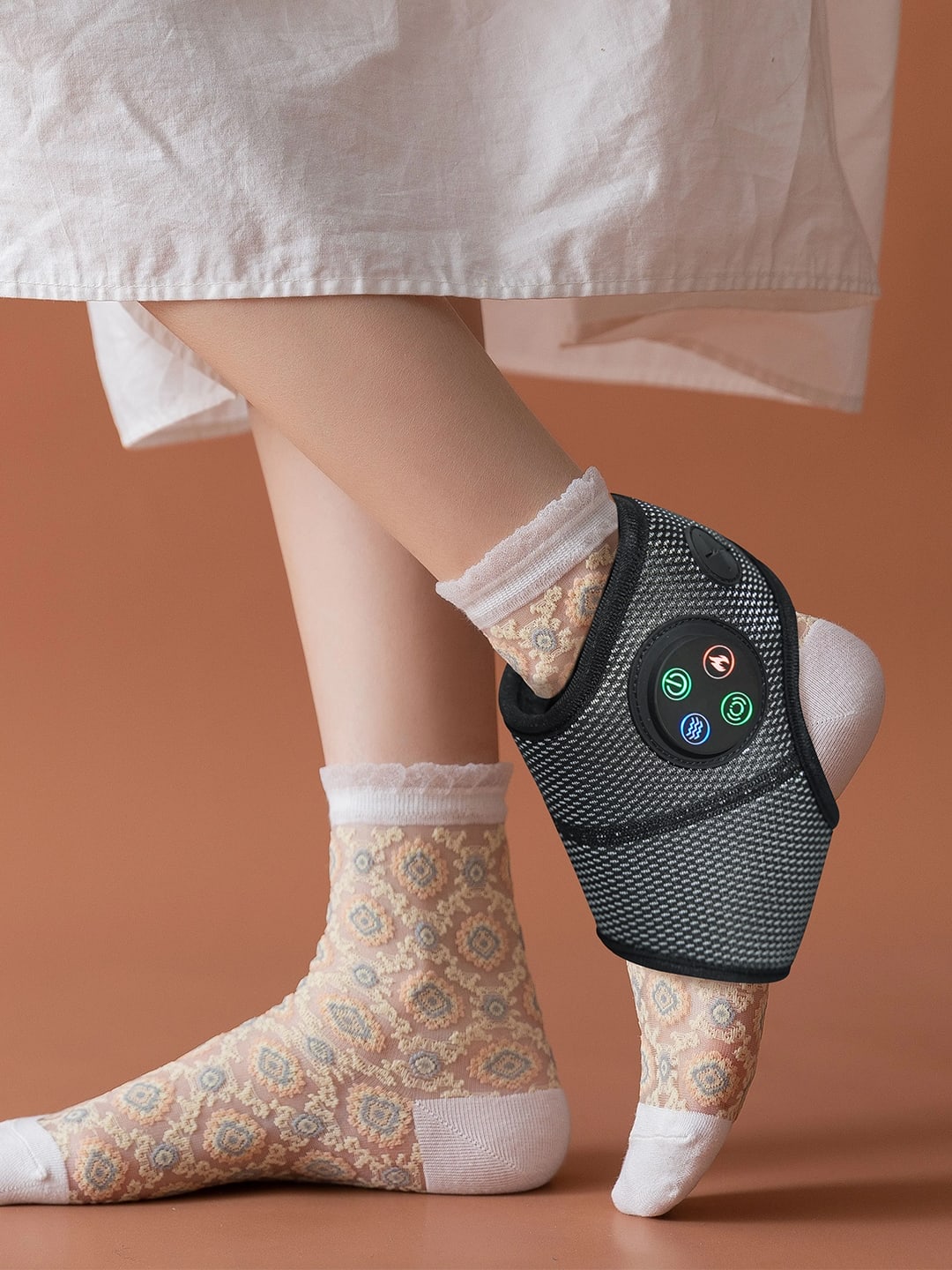Foot Massager for Diabetics: Safe for Sensitive Feet?
- By Grace
- Updated on
Many middle-aged and elderly individuals, especially those with diabetes, wonder if foot massagers are safe due to potential risks to compromised foot health. This article aims to address these valid concerns by exploring the nuances of foot massager use for diabetic patients, enabling informed decisions for their well-being.
What is Diabetic Foot & Its Vulnerabilities?
Understanding the unique challenges of diabetic feet is crucial when assessing the safety of any foot massage equipment. Diabetes often leads to two major complications that significantly increase foot vulnerability: neuropathy and peripheral artery disease.
Neuropathy (Nerve Damage): This diminishes sensation, meaning a diabetic individual might not feel heat, pressure, or minor injuries that would alert someone else. This is a critical factor for devices that apply heat or pressure.
Poor Blood Circulation: Often associated with diabetes, poor circulation means that any foot injury takes longer to heal and is more prone to infection. A minor bruise or blister that might be negligible for a healthy foot could quickly escalate into a severe ulcer or infection for someone with diabetes.
This delicate balance makes the choice of personal care devices, like a foot massager, incredibly important, demanding vigilance in protecting these vulnerable areas.


Understanding How Foot Massagers Work & Potential Risks
Ordinary foot massagers present significant risks for individuals with diabetes due to their standard operating mechanisms. Many conventional devices use generic heat settings, where temperatures exceeding 40°C can cause severe low-temperature scalding in diabetic patients with reduced nerve sensitivity, a "silent threat" since warning signals aren't received. Beyond heat, the fixed mechanical pressure from rollers or compression can worsen existing ulcerated areas, corns, calluses, or fragile skin, leading to new injuries. From a design perspective, a "one-size-fits-all" approach to pressure is inadequate for sensitive users. Furthermore, if these devices are made from inferior materials, they can become breeding grounds for bacteria, significantly increasing the risk of infection. These temperature risks, pressure hazards, and hygiene concerns make careful selection of foot massage equipment crucial for diabetic foot care.
Features of Specialized Foot Massagers for Diabetic Care
When selecting a foot massager for diabetic patients, the focus shifts from mere comfort to meticulously engineered safety. While no device can eliminate all risks, diabetic-specific foot massagers significantly reduce them through features tailored for vulnerable feet.
These advanced devices prioritize safety with:
Precise Temperature Control: They offer multi-level temperature adjustments, often with overheat protection and automatic shut-off after a safe duration (typically 15 minutes). This prevents low-temperature scalding, a silent threat for those with diminished sensation.
Adaptive Pressure Systems: Instead of fixed pressure, these massagers utilize air pressure regulation technology that dynamically conforms to various ankle shapes. This prevents excessive localized pressure, thereby safeguarding against secondary injuries to fragile skin or existing conditions.
Hygienic Materials: High-quality, breathable, and moisture-permeable fabrics, such as imported diving fabric, are commonly used. These materials help maintain a healthier contact environment, significantly reducing the risk of bacterial growth and infection.
Multi-functional Design: Many specialized models, like the Klcosy, integrate various therapies such as air pressure, heat, vibration, and red light. These multi-modal massage foot massager systems offer combined modes and multiple pressure settings, allowing for a highly personalized and adaptable experience that addresses diverse care needs while minimizing risks associated with less controlled, single-function devices.
These innovations represent a significant advancement in supportive foot massage equipment for this sensitive user group, reflecting a design philosophy centered on anticipating and mitigating specific diabetic foot vulnerabilities.

Navigating Safe Use: A Wellness Coach's Practical Advice
Even with advanced specialized foot massagers, responsible use is crucial for middle-aged and elderly individuals with diabetes. Always consult your healthcare provider or a podiatrist before using any foot massager to ensure it's suitable for your specific condition, especially if you have neuropathy or existing ulcers. Once cleared, start slowly with the lowest intensity and heat settings for short durations (e.g., 5-10 minutes). Make it a habit to inspect your feet daily—both before and after each use—for any signs of redness, irritation, or swelling. Maintain strict foot hygiene, ensuring your feet are clean and dry, and regularly sanitize the massager's contact surfaces according to manufacturer instructions to prevent bacterial buildup. Vigilance is key to making safe, sustainable choices for your foot health.
When to Consult Your Doctor: Prioritizing Your Health
While a specialized foot massager can be a great tool for daily comfort, it's never a substitute for professional medical treatment. You should immediately stop using your massage foot massager and seek medical attention if you experience any new pain, numbness, tingling, or increased swelling in your feet or legs. Furthermore, using a foot massager is strictly contraindicated if you have any open sores, ulcers, blisters, or infections on your feet, as this can worsen the condition. For those with severe peripheral neuropathy, unmanaged diabetes, or structural foot deformities requiring specialized support like a drop foot brace, relying solely on a massager is insufficient and potentially dangerous; professional medical intervention is always paramount for comprehensive care and long-term well-being.
Conclusion
The journey to embracing a foot massager as a diabetic patient doesn't have to be fraught with uncertainty. While ordinary **foot massage equipment** may indeed pose risks due to uncontrolled heat and pressure, the landscape of **massage foot massager** technology has evolved. Specialized devices, meticulously designed with features like precise temperature regulation, air pressure technology, and hygienic materials, offer a much safer alternative for supportive daily care.
Ultimately, your safety and well-being are paramount. These tools are designed to complement, not replace, medical guidance. As someone dedicated to blending ergonomic design with wellness, I truly believe in the potential of these innovations to enhance comfort and circulation. However, always remember to consult your doctor before integrating any new routine or device, especially a **foot massager**, into your diabetes management plan. This collaborative approach ensures you reap the benefits while navigating any potential risks with confidence and care.
Frequently Asked Questions About Foot Massagers
Does afoot massagerhelp with plantar fasciitis?
Yes, for many individuals, a foot massager can provide significant relief from plantar fasciitis. By targeting the plantar fascia ligament and surrounding muscles, massage can help to reduce tension, break up adhesions, and improve flexibility, which are all beneficial for managing the pain associated with this condition. Devices with rolling or kneading actions are often particularly effective.
Can afoot massagerimprove blood circulation in feet and legs?
Absolutely. One of the primary benefits of using a foot massager, including those that incorporate heat or gentle compression, is its ability to stimulate blood flow. The kneading, vibrating, or rolling motions help to dilate blood vessels and encourage circulation, which can reduce swelling, alleviate fatigue, and promote overall leg and foot health. This is particularly beneficial for those who spend long hours on their feet or have sedentary lifestyles, though for diabetic patients, this benefit must be weighed against safety considerations.
Arefoot massagersgood for neuropathy?
For some types of neuropathy, particularly those causing pain or tingling, a foot massager might offer symptomatic relief by stimulating nerves and improving local blood flow. However, for diabetic neuropathy, where sensation is significantly diminished, caution is paramount. The lack of sensation means you might not feel damaging heat or pressure. Therefore, only specialized foot massagers with precise control and expert medical consultation are advisable for individuals with diabetic neuropathy to ensure safety and avoid further harm.




